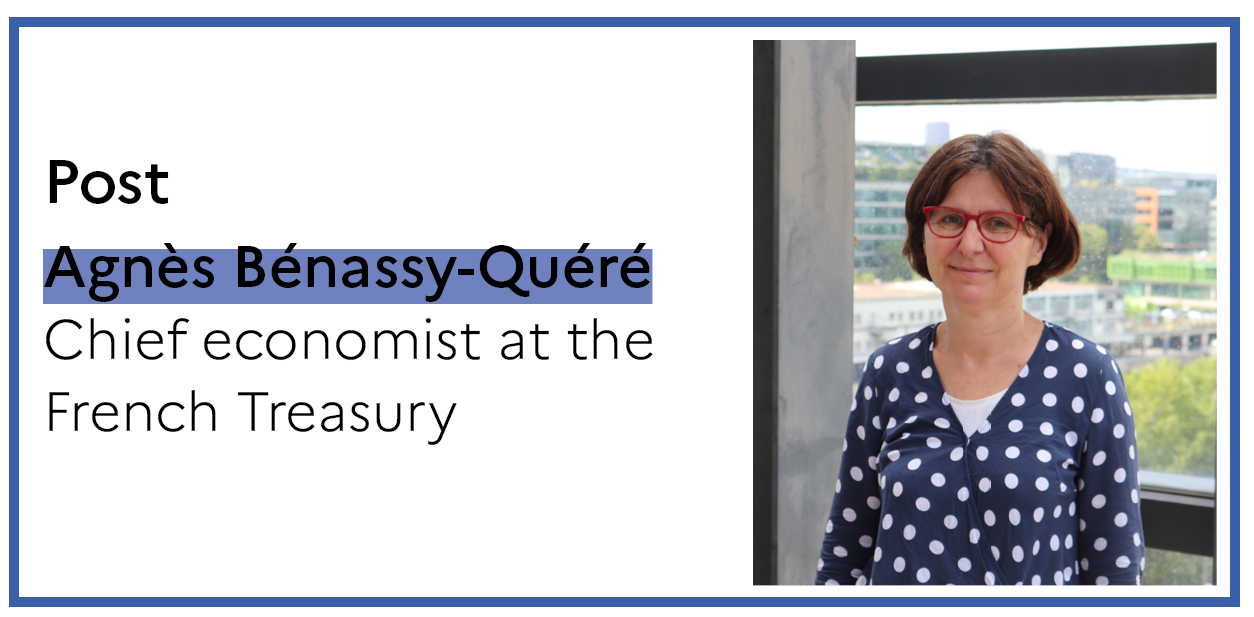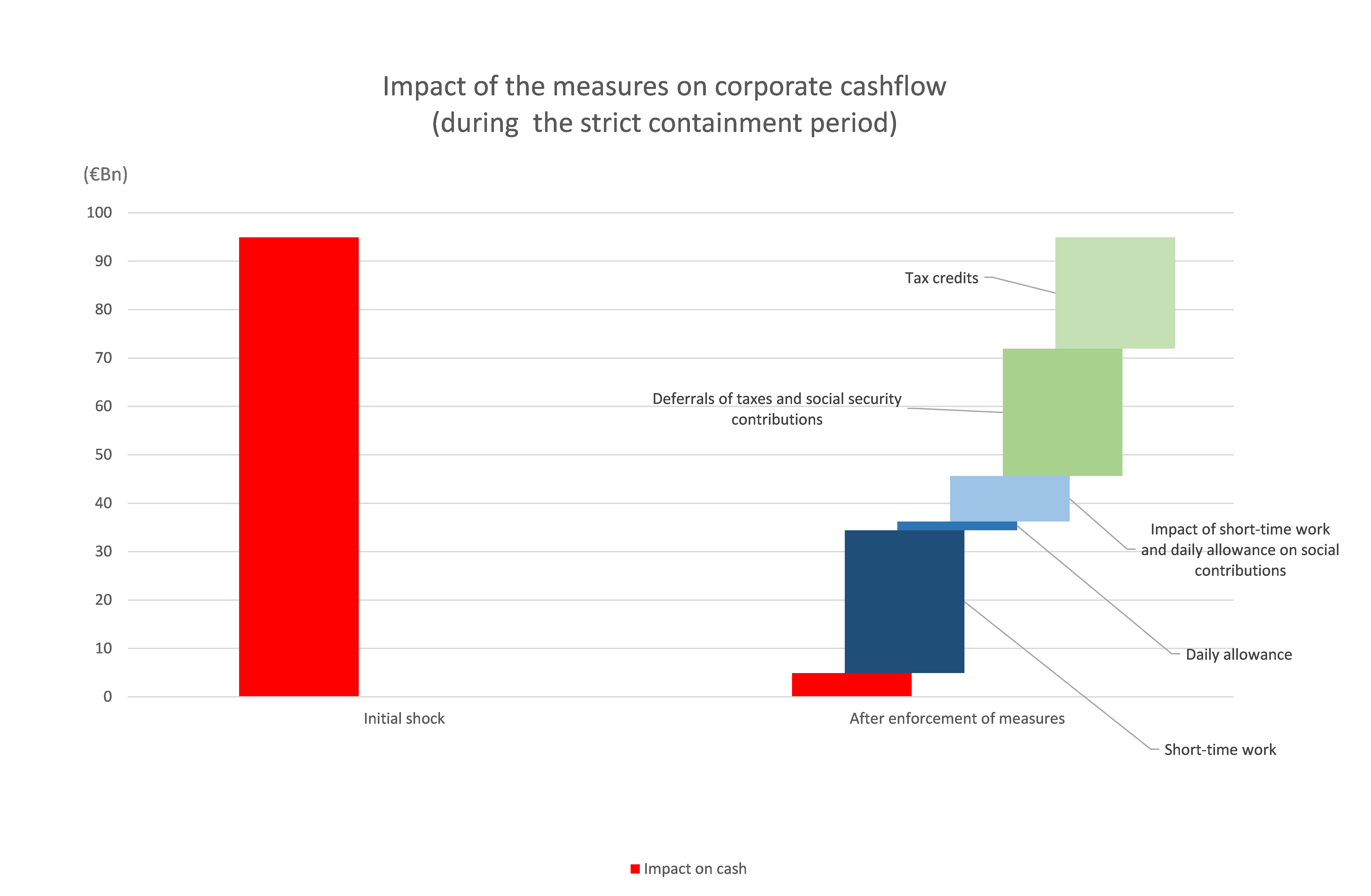Equity gaps in the French corporate sector after the great lock-down

The lock-down
The Covid-19 pandemic represents an unprecedented shock to operating accounts. Depending on the sector, firms find it difficult to maintain their normal levels of production due to a combination of (1) administrative closures, (2) decline in productivity and (3) fall in demand. The drop in turnover, combined with the existence of fixed costs, translates into lower cash-flows and possibly into losses and defaults.
Faced with this situation, the French government has implemented two types of measures:
- Liquidity support: deferrals of taxes and social security contributions, State-guaranteed loans;
- Solvency support: short-time work, solidarity fund.
In the short run, both types of support improve firms’ liquidity; in the longer term, though, only the latter improve their solvency.
Figure 1 shows that, during the eight weeks of general lock-down (March to May), public support could have absorbed around 95% of the shock suffered by French firms: for a total of € 95 billion in lost value-added, the the drop in cash was only € 5 billion.
Figure 1
Sources : French Treasury
Of course, business situations are highly heterogenous. France has around 3.8 million companies according to INSEE, including around 250 large companies and 5,600 mid-size companies (ETI).[1] The overwhelming majority of businesses in France are SMEs, the vast majority of which are very small companies (less than 10 employees). These companies can be very vulnerable to a lock-down shock. By simulating the evolution of the balance sheets of almost all French companies (INSEE-FARE database), the Treasury has found that short-time work and the solidarity fund could have reduced by around 75% the number of companies turned illiquid (i.e. unable to meet their deadlines) by the lock-down, and this even before accounting for State-guaranteed loans. The methodology is detailed in the box below.
The economic crisis
However, the shock for companies is more long-lived than the lock-down itself, and moreover the tax and social security liabilities will need to be repaid. From March to June 2020, French firms have borrowed heavily, in particular by resorting to State-guaranteed loans (more than 500,000 companies have benefited from these loans) but also, for larger firms, by borrowing on the bond market. According to the Banque de France, corporate gross debts (excluding tax and social security liabilities) increased by € 152 billion during this period. On average, companies kept most of the borrowed funds (i.e. € 142 billion) in liquid form, probably in anticipation of future difficulties.
Over year 2020, the Treasury estimates that the public sector could absorb around 2/3 of the aggregate cost of the shock, leaving households and businesses to share the remaining. This is where the risk of insolvency comes in: having increased their leverage during the lock-down, a number of companies will be at risk of insolvency (debts greater than the assets). Assuming a 6-month shock (strict lock-down followed by a gradual resumption of activity over the rest of the year), and without additional support, business failures could increase by around 70% compared to the usual number of failures (52,000 in 2019 according to Altares).
The equity gap
Beyond insolvency, the challenge of the coming months will be that of investment: without investment, the French economy could enter an anemic spiral in which low investment would gradually reduce production capacity, which would weigh on employment and income and therefore on consumption, which in turn would discourage investment, etc.
Economic research[2] has shown that more leveraged firms tend to invest less especially during a crisis. Highly leveraged but viable firms will therefore need recapitalization.
For SMEs and midcaps, the Treasury estimates equity gap at around € 10 billion for a few tens of thousands firms. Of course, these estimates will have to be adjusted depending on the path of the recovery and on the provisions of the recovery plan (in particular with regard to cuts in production taxes).
The € 10bn amount may be compared to households’ financial savings of nearly € 4,000 bn, including new savings accumulated during the lock-down which may amount to € 100 bn by the end of the year. Households will likely remain reluctant to take risks. However, it is the job of financial intermediaries to offer savings products combining limited risk-taking and a higher return than those on sovereign bonds - currently negative up to the 10-year maturity.
Insofar as the crisis could kick viable firms out of the market, public intervention is justified. Indeed, these companies would not necessarily be replaced by more productive firms, as it is the case in principle in normal times ("creative destruction").[3]
Box: methodology
The microsimulation model of the French Treasury aims at examining the consequences of Covid-19 on illiquidity (when a company runs out of cash) as well as insolvency (when the asset / debt ratio falls below 1).[4] The model is based on FARE 2017 data from Insee, which lists the balance sheets and income statements of almost all companies in France (n = 3.8 million companies). After excluding a number of
companies for which the information cannot be used, the model restricts the analysis to nearly 2 million companies representing 91% of the value-added of the French economy.
The aim is to measure the impact, on firms’ balance sheets, of sectoral shocks as estimated by INSEE during the Covid crisis.[5] Public policies put in place by the government are also simulated: deferrals of taxes and social security contributions, short-time work, solidarity fund (however excluding State guaranteed loans). The model accounts for fixed costs (such as rents), while other costs are supposed to partially adjust to the shock. Specifically, the wage bill and input purchases are assumed to adjust in proportion to the shock suffered by the company.
Illiquidity occurs when the initial cash position is depleted. Beyond this point, the firm is assumed to borrow, which increases the risk of insolvency and therefore the risk of default.
***
Read more :
>> Version française : Les besoins des entreprises françaises en fonds propres à l'issue du "grand confinement"
>> All posts by Agnès Bénassy-Quéré, chief economist - French Treasury
